SETTING WINGS 3D PREFERENCES
Introduction
You can bring up the Wings 3D Preferences dialog box by selecting [Edit | Preferences] from the Main menu, or by clicking the Preferences icon on the Toolbar. There are many settings, ranging from altering the display colors to controlling the responsiveness of your mouse.
When in the Preferences dialog you can click or Tab from field to field to change your preference settings, and turn on/off toggles with the mouse. To save all the changes to your preferences click on the OK button in the main dialog box or, to abandon your changes, click the Cancel button.
Choose Color Dialog
The Choose Color dialog opens when a color option is changed.
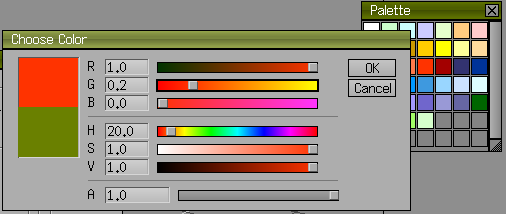 You can set the color using either RGB or HSV methods by entering the numeric values or by moving the sliders. Alternatively, use the color picker by moving the cursor out of the Choose Color dialog box and select an existing color, for example from the Palette window, with the eyedropper cursor. Some color options also provide a control for Alpha channel transparency.
You can set the color using either RGB or HSV methods by entering the numeric values or by moving the sliders. Alternatively, use the color picker by moving the cursor out of the Choose Color dialog box and select an existing color, for example from the Palette window, with the eyedropper cursor. Some color options also provide a control for Alpha channel transparency.
PREFERENCES DIALOG
The Preferences dialog box opens at the General menu tab, and there are blocks of related options on each menu tab, as shown in the screen shots below.
Edit | Preferences | General
You may want to change the various color settings, e.g. for Selection Color from Dark Red to a brighter color to enhance the visibility of selected items, or the Grid Color to something other than Dark Grey. Select the color you want to change with LMB and the Choose Color dialog box appears.
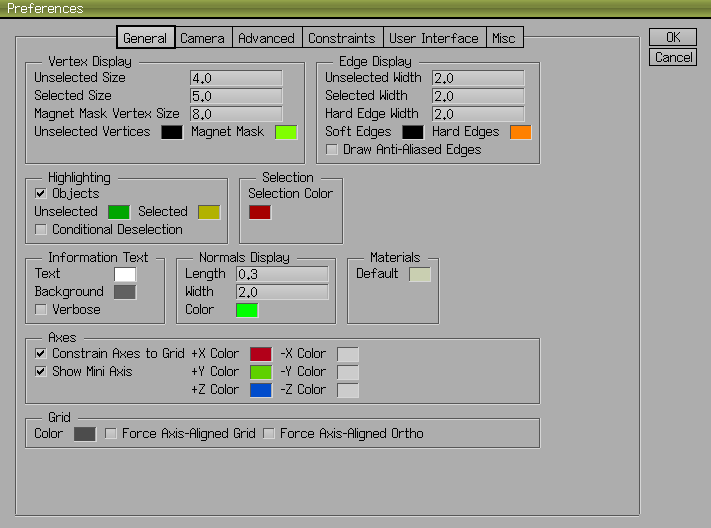
- Vertex Display – Change how vertices are normally displayed.
- Unselected Size – Size in pixels of unselected vertices (0.0 = not shown).
- Selected Size – Size in pixels of selected vertices.
- Magnet Mask Vertex Size – Size in pixels of magnet mask vertices.
- Unselected Vertices – Color of unselected vertices.
- Magnet Mask – Color of magnet mask vertices (including transparency).
- Edge Display – Change how edges are normally displayed.
- Unselected Width – Width in pixels of unselected edges.
- Selected Width – Width in pixels of selected edges.
- Hard Edge Width – Width in pixels of hard edges.
- Soft Edges – Color of soft edges.
- Hard Edges – Color of hard edges.
- Draw Anti-Aliased Edges – Toggle anti-aliasing for smoothing the display of edges.
- Highlighting – Change how mouse-over highlighting is normally displayed.
- Objects – Switch on highlighting for Objects (in addition to Face, Edge,Vertex).
- Unselected – Color for highlighting of items which are not yet selected.
- Selected – Color for highlighting of items which are already selected.
- Conditional Deselection – Deselecting keeps you in the same Selection mode, unless there is no selection.
- Selection – Change how selected items are normally displayed.
- Selection Color – Color for items currently selected (but not currently highlighted by mouse-over).
- Information Text – Change how the Status Bar shown in Geometry windows is normally displayed. (Note: the Information Line options are in the User Interface tab).
- Text – Color of text in the Status Bar.
- Background – Color of background for Status Bar (including transparency).
- Verbose – Show additional information (if available) about the selected items.
- Normals Display – Change how Normals are displayed; see [View | Show | Show Normals] which toggles display of normls.
- Length – Length in wings units of normals.
- Width – Width in pixels of normals.
- Color – Color of normals.
- Materials – Change how materials are displayed in the normal Wings 3D workspace.
- Default – Color of the default material. (Requires a reload of Wings 3D).
- Axes – Change the way the Axes are displayed.
- Constrain Axes to Grid – Limit the display of the axes to within the ground-plane grid area, instead of out to “infinity”.
- Show Mini Axis – Display the moving Mini Axes in the bottom left of the Geometry window. This option is independent of the display of the main axes, see [View | Show | Axes].
- (+/-X,Y,Z) Color – Color of the standard X, Y, Z axes, in either positive or negative directions. Also linked to the color of the Mini Axes display.
- Grid – Change the way the ground plane is displayed.
- Color – Color of the ground-plane grid lines.
- Force Axis-Aligned Grid – Always show the grid when the view is aligned along one of the major axes, regardless of current [View | Show | Ground Plane] setting.
- Force Axis-Aligned Ortho – Always go into Orthographic mode when the view is aligned along one of the major axes (see X, Y, Z Hotkeys) regardless of current [View | Orthographic] setting.
- Anti-Aliasing – This option only appears if the OpenGL implementation on your system supports this feature.
- Enable Multi-Sampling – Anti-Alias the whole interface, including polygons.
Edit | Preferences | Camera
By default, Wings 3D assumes a Three Button Scroll Mouse, and Wings3D Camera Mode. Other two or three button Mouse types will work as well.
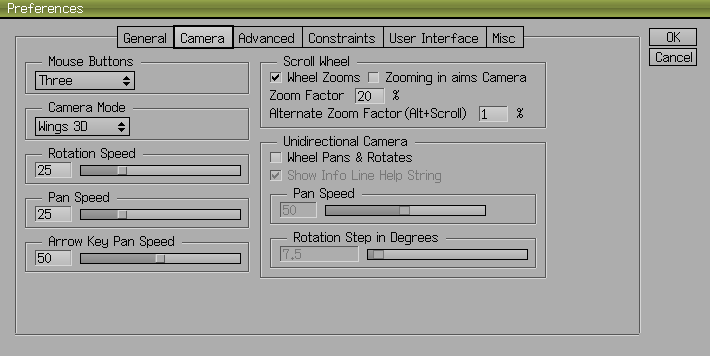
- Mouse Buttons – Set the option to One, Two or (the default) Three button mouse.
- Camera Mode – Camera mode and behavior. Linked to the number of mouse buttons. The default is Wings 3D. Nendo camera mode can be used with a one- or two-button mouse, and Blender camera mode can be used with a two- or three-button mouse. All other camera modes require a three-button mouse.
- Rotation Speed – Step size in pixels moved when the mouse is used to rotate the scene.
- Pan Speed – Step size in pixels moved when the mouse is used to pan the scene.
- Arrow Key Pan Speed – Step size in pixels moved when the Arrow keys are used to pan the scene.
- Scroll Wheel – Change the speed and behavior of zooming using a scroll wheel.
- Wheel Zooms – Use the scroll wheel to zoom.
- Zooming in aims Camera – Enables auto aiming while zooming the camera in when part of the model is highlighted.
- Zoom Factor – Percentage change in size of scene when zooming in/out.
- Alternate Zoom Factor(Alt+Scroll) – Alternative zoom factor setting, to give a choice of (slower) zooming behavior.
- Unidirectional Camera – Allows use of the scroll wheel to Pan in one direction (with Ctrl+Scroll) or Rotate (with Shift+Scroll) around one axis. The Alt key is used to pan/rotate in the opposite direction. This feature is an alternative to tumbling and dragging using mouse movements in camera mode.
- Wheel Pans & Rotates– Switch on use of scroll wheel for unidirectional camera mode.
- Show Info Line Help String – Display the additional options in the Information Line.
- Pan Speed – Step size in pixels moved when the scroll wheel is used to pan the scene.
- Rotation Step in Degrees – Step size in degrees when the scroll wheel is used to rotate the scene.
Edit | Preferences | Advanced
The defaults are usually fine for basic use.
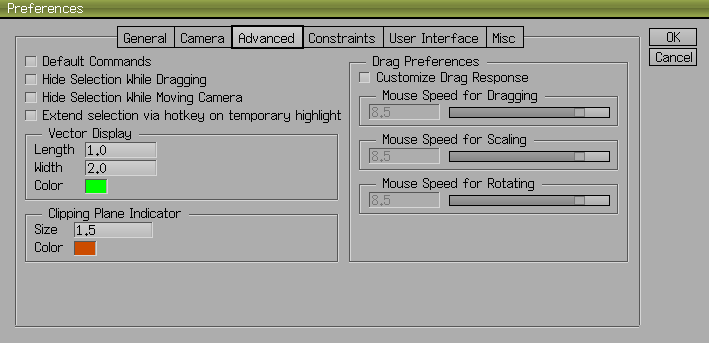
- Default Commands – Effectively ignored in this version.
- Hide Selection While Dragging – Don’t show the selection in any interactive command.
- Hide Selection While Moving Camera – Don’t show the selection when the camera is being moved.
- Extend selection via Hotkey on temporary highlight – Affects commands in the Select Menu: Select All, Edge Loop, Edge Ring, Select Similar, Similar Normals, Similar Materials, and Similar Area.
- Vector Display –
- Length – Length of vector in wings units of secondary selections.
- Width – Width in pixels of selected vector.
- Color – Color of selected vector
- Clipping Plane Indicator –
- Size – Size of user-defined clipping indicator.
- Color – Color of user-defined clipping indicator.
- Drag Preferences – Allows you to customize mouse sensitivity/speed during distance, scaling and rotation dragging operations.
- Customize Drag Response – Unchecked uses default settings.
- Mouse Speed for Dragging – Set relative speed for distance mouse motion.
- Mouse Speed for Scaling – Set relative speed for scaling mouse motion.
- Mouse Speed for Rotating – Set relative speed for rotation mouse motion.
Edit | Preferences | Constraints
The Constraints Menu tab shows the current values for each modifier in the constraint sets. A constraint is a keyboard modifier that controls step-wise changes during distance, scaling and rotation operations while dragging the mouse. Normally, mouse dragging will produce changes depending on your hand movements, or you can use the numeric Tab dialog option to specify the amount of change. When a modifier key is pressed during a dragging operation, the changes are in the step values defined for that modifier.
Each type of dragging operation has a main and alternate constraint set. You can switch between related constraint sets on-the-fly by pressing Shift+Tab while dragging in any tool. The information Line shows which options are currently available and whether the alternate constraints are in force.
- Distance Constraints / Alternate Distances – Two sets can be separately defined for distance constraints.
- Scale Factors / Reciprocal Factors – The reciprocal constraint values are automatically set equal to (1/Scale Factor) for each modifier.
- Rotation Constraints / Supplementary Angles – The supplementary constraint values are automatically set equal to (180 – Angle) for each modifier.
The Set Constraint commands in the Vertex, Edge and Face Menus allow you to capture a value for a distance, a scale percentage or an angle which is related to some aspect of the model, and to bind that value to a modifier key for further use.
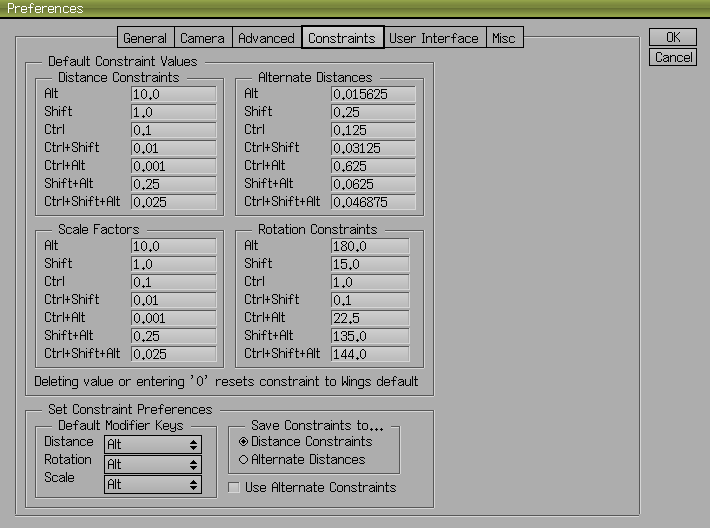
- Default Constraint Values – The current values for each of the modifier key combination. Any value captured by the Set Constraints command will change the relevant modifier. Deleting a value or entering ‘0’ resets a constraint to the default Wings 3D value.
- Distance Constraints – Constraints defined for modifier key(s) for distance operations. Values are in wings units.
- Alternate Distances – Alternate distance constraints defined for modifier key(s) for scale operations. Values are in wings units.
- Scale Factors – Constraints defined for modifier key(s) for scale operations. Alternate reciprocal constraints are stored automatically. Values are the relative scale factor.
- Rotation Constraints – Constraint defined for modifier key(s) for rotations. Alternate supplementary angle constraints are stored automatically. Values are in degrees.
- Set Constraint Preferences – Defines where the Set Constraints command stores the captured value. The Set Constraints command determines whether the value to be stored is a distance, scale or rotation modifier, depending on the context, and overwrites the current modifier value in the constraints set.
- Default Modifier Keys – Defines which modifier key is bound by default to the value captured.
- Save Constraints to… – For distance constraints, the captured value is stored in the Distance or Alternate Distances constraints set as default.
- Use Alternate Constraints – If checked, the alternate constraint set will be activated when a modifier key is used during a drag operation.
Edit | Preferences | User Interface
Chose different colors and transparency settings for the workspace. The Choose Color dialog controls are described above. Different screen fonts and language options are available, and the appearance of the Outliner and Geometry Graph windows can be tailored.
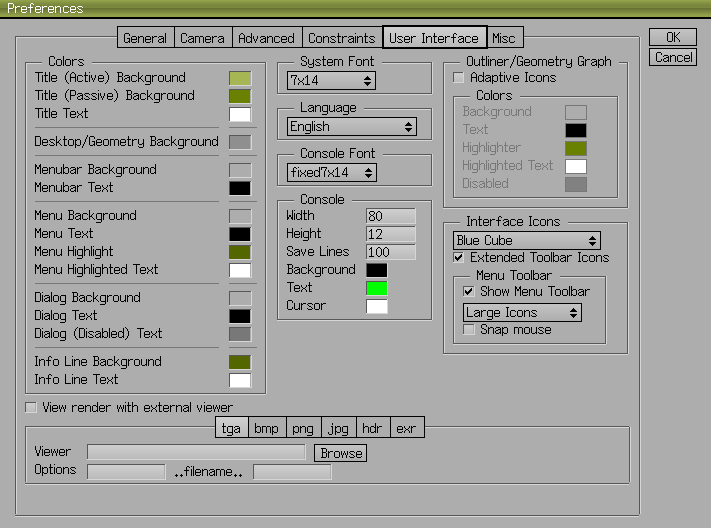
- Colors– Change the appearance of the workspace.
- Title (Active) Background – Color of the Title Bar of the active window (inc. transparency).
- Title (Passive) Background – Color of the Title Bar in inactive windows (inc. transparency).
- Title Text – Color of the text in a Window Title Bar.
- Desktop/Geometry Background – Background color of the workspace and Geometry windows.
- Menubar Background – Background color of the Main Menu.
- Menubar Text – Color of the Main Menu text.
- Menu Background – Background color of the Context Menu (inc. transparency).
- Menu Text – Color of the Context Menu text.
- Menu Highlight – Background color of a selected command in a Context Menu.
- Menu Highlighted Text – Color of the text of a selected command in a Context Menu.
- Dialog Background – Background color of dialog boxes (inc. transparency).
- Dialog Text – Color of text in a dialog box.
- Dialog (Disabled) Text – Color of text of disabled options in a dialog box.
- Info Line Background – Background color of the Information Line (including transparency).
- Info Line Text – Color of the text in the Information Line.
- System Font – Choice of font for standard text, including Chinese/Japanese/Korean. (Reload).
- Language – Choice of language for menus, information line, etc. (Reload).
- Console Font – Choice of font for text used in Console window. (Reload).
- Console – Configure the Console window.
- Width – Number of characters wide.
- Height – Number of lines shown.
- Save Lines – number of lines in the saved line cyclic buffer.
- Background – Background color of the Console window.
- Text – Color of the text in the Console window.
- Cursor – Color of the cursor in the Console window.
- Outliner/Geometry Graph – Configure the appearance of the Outliner and Geometry Graph windows.
- Adaptive Icons – Enable use of additional color themes in these windows.
- Background – Background of these windows (inc. transparency).
- Text – Color of normal text.
- Highlighter – Background color of a selected item.
- Highlighted Text – Color of highlighted text for selected items.
- Disabled – Color of disabled items.
- Adaptive Icons – Enable use of additional color themes in these windows.
- Interface Icons– Choose the style of the Menu Toolbar Icons from pyramid, cube or cylinder. (Reload).
- Extended Toolbar Icons – Adds additional Icon buttons (Redo, etc) to the Menu Toolbar (in all Geometry Windows). (Reload).
- Menu Toolbar – Adds a mini-toolbar to the top of the Context Menus.
- Show Menu Toolbar – Enable mini-toolbars.
- Large/Small Icons – Use large or smaller icos in the mini-toolbars.
- Snap mouse – On opening the Context Menu, snaps the mouse to the mini-toolbar.
- View render with external viewer – Use a different image viewer to view images after rendering. Select one of the format tabs (tga, bmp, png,..) then set the Viewer for that image format. By default the internal OpenGL viewer will be used.
- Viewer – Type the path or Browse to find the viewer executable.
- Options & ..filename.. – Any required additional parameters for this viewer.
If you want to use an image viewer other than the built-in image viewer to display images after rendering is complete, you can specify one by clicking the Browse button and locating the executable for that image viewer.
Edit | Preferences | Misc
A ragbag of useful options which have nowhere else to go.
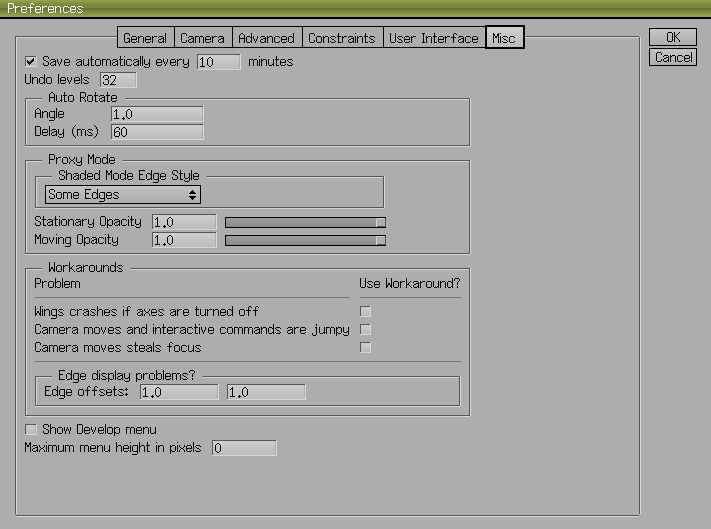
- Save automatically every {user defined} minutes.
- Undo levels – Default is 32. Set lower to reduce memory footprint if needed.
- Auto Rotate– Default settings for the Auto Rotate camera view (U Hotkey).
- Angle – Step change of the rotation.
- Delay (ms) – Speed of rotation, which can be changed by +/- while rotating.
- Proxy Mode
- Shaded Mode Edge Style – “Cage, Some Edges, All Edges”
- Stationary Opacity –
- Moving Opacity –
- Workarounds
- Problem – Only experienced on some systems or with some graphics drivers. Only activate the workaround if you think it may be relevant to you – see the Information Line.
- Edge display problems? – Edge offsets –
- Show Develop menu – Adds the Develop Menu to the main menu bar which has a number of tools for the Wings developers.
- Maximum menu height in pixels – Menus are clipped if they are longer than the window height, and are continued in a ‘More…’ sub-menu. A value less than 1 sets automatic menu clipping.
Quick Tip: Reset to ‘Factory Settings’
It’s tempting to play around with the Preference settings before you know what you are doing. Go ahead! But it’s quite possible that you could end up in some confused state, or with something more colorful than you meant. One option is to try the [Edit | Themes ] command to recover from a “technicolor yawn”. If the situation requires a Reset – unfortunately, there is (currently) no ‘Reset Preferences’ button … but there is a quick and dirty trick:
- Find the location of the master file: preferences.txt. See the Erlang console window (you may have to scroll up to the beginning).
- Exit Wings 3D.
- Delete the master file: preferences.txt.
- Restart Wings 3D.
If Wings 3D cannot find preferences.txt when it starts up – as happens when launched for the first time – then Wings 3D simply creates a full default set. The master preference file is then saved when Wings 3D closes.
Note: The facility to save and re-load subsets of preferences is described in Saving and Loading Different Preference Files.